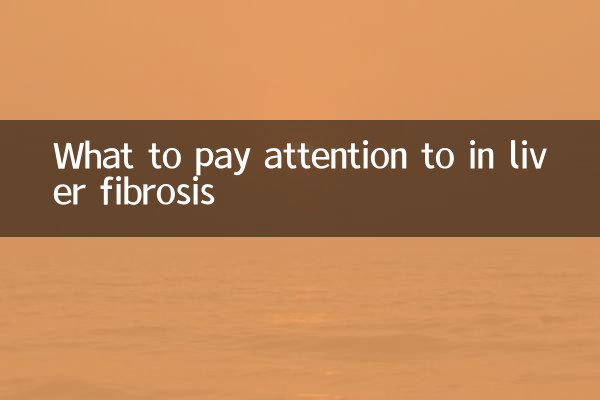What to pay attention to in liver fibrosis
Liver fibrosis is a pathological change that occurs after long-term damage to the liver. Without timely intervention, it may develop into cirrhosis or even liver cancer. In recent years, with changes in lifestyle and dietary habits, the incidence of liver fibrosis has gradually increased. This article will combine the hot topics and hot content on the Internet in the past 10 days to introduce you to the precautions for liver fibrosis in detail and provide structured data reference.
1. High-risk factors for liver fibrosis

The occurrence of liver fibrosis is related to many factors. The following are common risk factors:
| high risk factors | illustrate |
|---|---|
| viral hepatitis | Long-term infection with viruses such as hepatitis B and C can cause liver damage |
| alcohol abuse | Long-term excessive drinking can directly damage liver cells |
| nonalcoholic fatty liver disease | Fat accumulation caused by obesity, high-fat diet, etc. |
| drugs and toxins | long-term exposure to certain drugs and chemicals |
| autoimmune disease | Such as autoimmune hepatitis, etc. |
2. Early symptoms of liver fibrosis
Early symptoms of liver fibrosis are often not obvious and can easily be ignored, but the following symptoms require vigilance:
| symptom | frequency of occurrence |
|---|---|
| Fatigue | high |
| Loss of appetite | middle |
| Dull pain in right upper abdomen | middle |
| Itchy skin | Low |
| unexplained weight loss | Low |
3. Preventive measures for liver fibrosis
The key to preventing liver fibrosis is controlling risk factors and maintaining a healthy lifestyle:
1.Regular physical examination: It is recommended that high-risk groups undergo liver function tests every 6-12 months.
2.Control drinking: Daily alcohol intake should not exceed 25 grams for men and 15 grams for women.
3.healthy eating: Reduce high-fat and high-sugar foods and increase the intake of vegetables and fruits.
4.Proper exercise: At least 150 minutes of moderate-intensity exercise per week.
5.Avoid drug abuse: Especially drugs that are harmful to the liver.
4. Treatment recommendations for liver fibrosis
If liver fibrosis has been diagnosed, the following treatment principles need to be followed:
| Treatment measures | Specific content |
|---|---|
| Cause treatment | Treatment for the primary disease, such as antiviral treatment for hepatitis B |
| antifibrotic treatment | Use anti-fibrotic drugs under the guidance of a doctor |
| nutritional support | Get enough protein and vitamins |
| Regular monitoring | Assess disease progression with imaging and blood tests |
5. Dietary recommendations for patients with liver fibrosis
A reasonable diet is crucial for patients with liver fibrosis. The following are specific dietary recommendations:
| food category | Recommended intake | limit intake |
|---|---|---|
| protein | High-quality protein (fish, chicken breast, soy products) | Red meat, processed meat products |
| carbohydrate | Whole grains, cereals | Refined sugar, sweets |
| Fat | Unsaturated fatty acids (olive oil, nuts) | Animal fats, fried foods |
| vitamins | Fresh fruits and vegetables (especially those rich in vitamins C and E) | none |
6. Common misunderstandings about liver fibrosis
In hot discussions in the past 10 days, it was discovered that the public has some common misunderstandings about liver fibrosis:
1.Misunderstanding 1: "The absence of symptoms means the liver is healthy" - The liver has a strong compensatory capacity, and symptoms are often severe when they appear.
2.Misunderstanding 2: "You can take liver-protecting medicines at will" - Any medicine must be used under the guidance of a doctor. Abuse of medicines can damage the liver.
3.Misunderstanding 3: "Fat liver is just a small problem" - If fatty liver is not controlled, it can also lead to liver fibrosis.
4.Misunderstanding 4: "Liver fibrosis cannot be reversed" - Early liver fibrosis can be reversed with appropriate treatment.
7. Latest research progress on liver fibrosis
According to recent hot scientific research reports, the following new discoveries have been made in the field of liver fibrosis research:
1. The relationship between intestinal flora and liver fibrosis has received widespread attention, and regulating intestinal flora may become a new treatment direction.
2. Non-invasive diagnostic technology has made progress, and the degree of fibrosis can be more accurately assessed through blood markers and imaging examinations.
3. Breakthroughs have been made in the research and development of targeted therapeutic drugs, and some new drugs have shown good anti-fibrosis effects in clinical trials.
Conclusion
Liver fibrosis is a preventable and treatable disease. The key lies in early detection and early intervention. By controlling risk factors, maintaining a healthy lifestyle and regular physical examinations, the occurrence and development of liver fibrosis can be effectively prevented. If liver fibrosis has been diagnosed, there is no need to panic. With standardized treatment under the guidance of professional doctors, most patients can achieve a good prognosis.

check the details

check the details